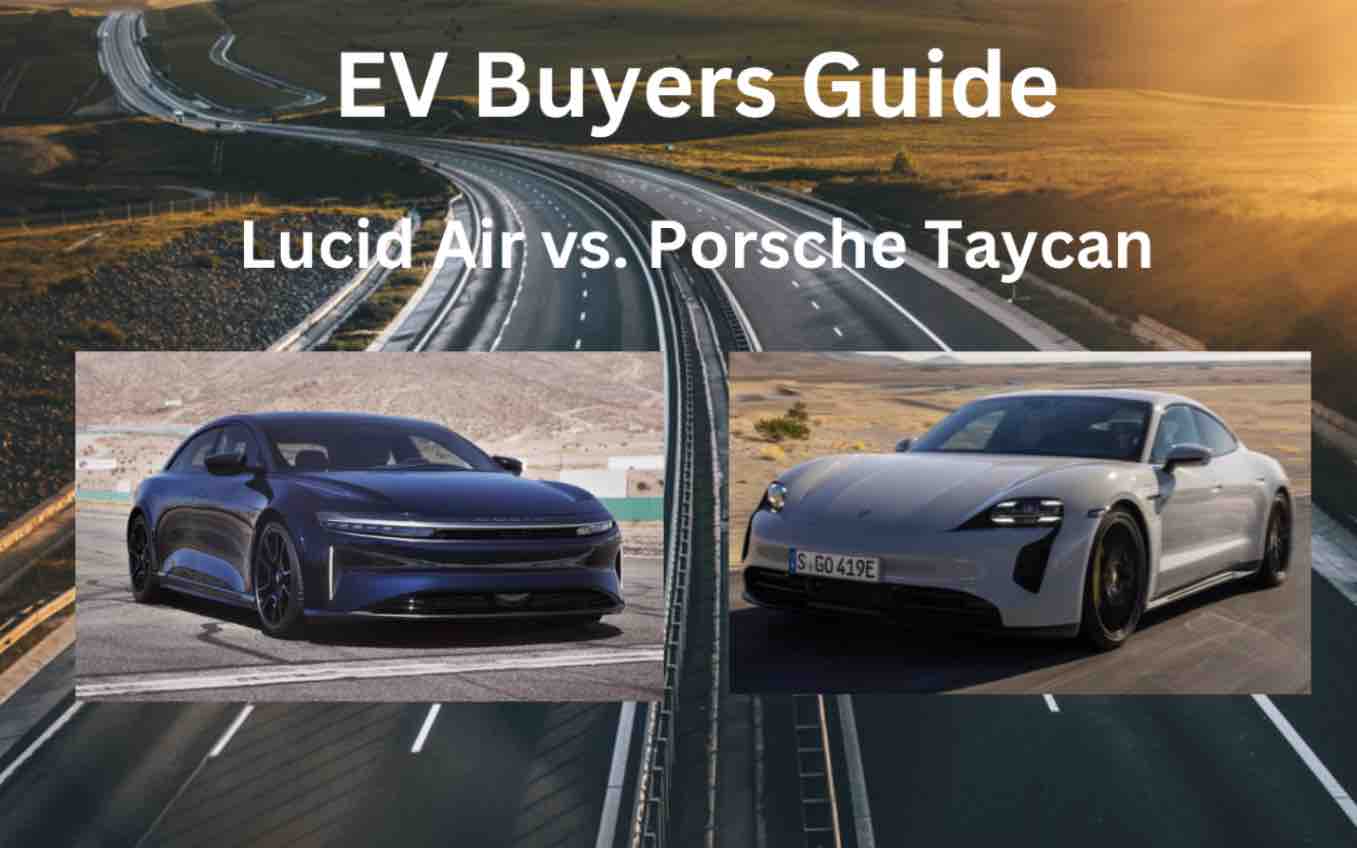The battle of luxury electric vehicles (EVs) rages on. Lucid has been in car journalists’ feeds for many reasons. The most noteworthy moment was when the Lucid Air sedan beat Tesla’s record for battery range, breaking the 400-mile barrier multiple times.
The Porsche Taycan is not the fastest model from the German brand, but it’s impressive nonetheless. Any Porsche is a pinnacle of luxury driving.
When compared together, the cars aren’t that different. Each offers a decent range, is pretty quick on acceleration, and offers amenities anyone would love to have in their vehicle.
Here’s how they stack up against each other.

Photo Courtesy Lucid Motors
Lucid Air
Car journalists describe the Air to be the first real challenger to Telsa. That sentiment is based on the performance of the engineering. With a 0-to-60 time of 3.0 seconds, it will always be a fast sedan. Few non-sports EVs can hit that.
The Air has five editions: Pure RWD, Pure AWD, Touring AWD, Grand Touring AWD, and Sapphire AWD. They have various performance boosts and extended ranges. The downside is they increase by a few thousand dollars per edition.
The standard model, Air Pure, runs close to $78,900. Every version increases after that, with the Sapphire costing around $250,000. Almost all Air models get 400 miles of range. The battery gets 300 miles back with 21 minutes of direct-current charging. New Air owners get three years of free charging from Electrify America.
The interior is comparable to a Rolls-Royce. Executive Rear Seating allows front seats to recline without sacrificing passenger comfort.
A massive glass roof lets in natural light. The infotainment system is highly sophisticated, with Amazon Alexa voice recognition, Apple CarPlay, and GPS. Almost every facet of the car runs through the central touchscreen. Climate control and driver assistance are all available on the screen. Lucid does not have manual buttons for these functions.
Safety features include forward-collision warning, automated emergency braking, blind-spot monitoring, adaptive cruise control, lane-keeping assist, and rear cross-traffic alerts. The Air can also receive over-the-air software updates.
Lucid will add Level 3 self-driving technology to future Air models. The company plans to compete in the autonomous driving market.
Though it hasn’t yet been tested by the Insurance Institute for Highway Safety (IIHS) or the National Highway Traffic Safety Administration (NHTSA), Euro NCAP gives the Air a five-star safety rating.

Photo Courtesy Porsche
Porsche Taycan
Considered a rival of Lucid and Tesla, the Porsche Taycan offers everything a German sports car would: passion, acceleration, and luxury. The 402-hp engine gives the Taycan the jump a Porsche is known for. It has multiple editions: base, 4S, GTS, Turbo, Turbo S, and Taycan Cross Turismo.
The standard Taycan starts at $92,550 MSRP. It increases across each version. You’re paying for more power in these models but not really adding more range. The base model gets around 208 miles, but versions like the Cross Turismo get closer to 240 miles. These are also more expensive. A Turbo S can run you close to $200,000.
Of course, the horsepower goes up with each version. The Turbo S edition has 750 horses underneath the hood. The 4S version has adaptive suspension in addition to 552 hp to make it more quick. Track tests showed the Taycan reach 60 mph in 3.4 seconds, and the Turbo version can do it in 2.6 seconds. It’s not as fast as the 911, but it excites for a sedan.
The battery size varies across each model, meaning the charge return rate is not the same across the board. Most Taycans have an 800-volt battery that has 270 kWh of charging. It can reach 80% full battery in 23 minutes.
Inside, the leather look melds well with the tech-savvy infotainment system. It comes with climate control, massaging and heated seats, a heated steering wheel, and more.
These are not all standard, though. You will have to pay more for some of these features. The infotainment is touchscreen and comes with Apple CarPlay/Android Auto.
IIHS or NHTSA haven’t rated it, but Euro NCAP gives similar models a five-star safety rating. Some safety features include adaptive cruise control, stop-and-go technology, remote control parking, and night vision.
Closing Thoughts
It’s hard to separate the differences between these two cars other than the glaringly obvious ones. Lucid has more safety features and more battery range, with the 400-mile range the Air boasts. The Taycan has yet to crack the 300-mile threshold.
Price-wise, the base models are relatively similar, and both have higher-luxury, more expensive versions, with the best of the best being close to $200,000 or more. The Air Pure might win there, being that it’s only $78,900, but that sacrifices AWD — and you have to pay more for the Pure AWD.
Also, neither model qualifies for clean-vehicle tax credits. The Lucid is manufactured in North America; however, it is above the $55,000 limit for electric sedans outlined in the Inflation Reduction Act. Porsche cars aren’t produced in North America, and the Taycan is also above the price limit. Buyers will have to pay the MSRP in full.
Both are about the same speed, but Porsche has Turbo versions that set it apart from the other Lucid vehicles. Lucid also markets itself as more of a comfortable luxury EV. The Taycan is something in between a four-door sports car and a super-charged sedan.
The Air has better storage space thanks to its “frunk,” but that’s not the main selling point. Both have Apple CarPlay, but Porsche has Android Auto, and Lucid has Amazon Alexa. Self-driving tech also gives the Air a few more points. However, both of these EVs are luxurious and expensive. Both offer good range and charging rates. You’re paying for luxury no matter what.





